The Token2049 Revelation: Innovation Exhaustion, Capital Closure, and the Silent Migration of the Crypto Industry
- 核心观点:Token 2049反映加密市场分化与创新瓶颈。
- 关键要素:
- 活动规模缩减,私局取代公开交流。
- RWA与稳定币成焦点,传统金融加速融合。
- 营销转向交易所,Twitter引流效率下降。
- 市场影响:推动行业聚焦实际应用与精准营销。
- 时效性标注:中期影响
Token 2049 Singapore took place in Singapore from October 1st to 2nd, 2025. As one of the world's largest Web 3 events, Singapore has become a hub for crypto innovation in Asia and beyond. The conference brought together entrepreneurs, investors, developers, and media from around the world, focusing on hot topics such as crypto finance, infrastructure, RWA, and AI x Web 3. In addition to the main venue, thousands of surrounding events were held throughout the city, including meetups, workshops, hackathons, dinners, and parties.
BlockBeats editors have compiled several "mini-essays" on Token 2049 Singapore for everyone to see the experiences and insights of these VCs and KOLs who attended the event on site, so as not to miss out on cutting-edge hot topics.
Scott (Founder of Monsterblockhk.eth)

After returning to Canada from Token 2049 SG, I saw many people tweeting about their anxiety. Seeing certain traders and influencers (KOLs) making hundreds of thousands of U.S. dollars a year, while I was only making 10,000 U.S. dollars a month, I realized this FOMO mentality might eventually become a liability. I originally thought the SG market would shrink this year, as I've always believed the market is still in a phase of short-term surges driven by BTC, ETH, and a few narratives, not a full-blown bull market. That's why you see many influencers around you struggling to make sense of it.
For me, the only things worth attending are ecosystem events. I went to SuiFest to meet @Scallop_io, @johnny_0168, and @djchrisssssss, and also visited $SCA. I went to Solana APEX to chat with @wangmeili_333 about @TradeNeutral, and finally got to meet and say hello to Vesper @1 cryptosheep. We're going to work together on things in Hong Kong.
Other side events are indeed much less common than last year, and I'm sure many people have noticed this. If I were to link this to the market, I'd say it's because the market is truly bad, and only exchanges are consistently profitable, allowing them to expand. Additionally, a few ecosystem narratives are involuntarily involuted, such as the ICM, a narrative that's been widely discussed recently. Also, because market participants aren't as strong as they once were, project owners, facing limited revenue, are naturally less inclined to hold events. You could argue that the cryptocurrency world is still lively, because where people gather there's excitement, but it's also clear that we're not yet in the midst of a massive bull market, where everything is flourishing. Otherwise, why haven't we seen a massive influx of external capital, or have older generations asked us how to buy cryptocurrency?
Going back to the FOMO mentality mentioned at the beginning of this article, this is also something I learned from this work trip. Because many people go to Singapore for meetings, or are introduced to project BDs by acquaintances, they will hear a lot of things, so everyone will greatly increase their general knowledge.
I think the cryptocurrency world, like life, isn't about how many ways there are to make money, but whether you can choose the path that best suits you. Someone who earns hundreds of thousands of U.S. dollars monthly through trading is the result of hundreds or thousands of days of backtesting and resource investment. On the other hand, they might not be as good at building a good social media presence or writing articles, right? The most important thing is that when we see other ways to make money in the market, we can reflect on what we're doing and see if there's anything worth learning from, which allows us to grow, rather than just copying what others do. That's how the saying "neither high nor low" comes into play. Everyone in the cryptocurrency world should delve deeply into their strengths, find their own path, and then continue to delve into becoming the best. If this leads to positive EV in the long run, why not?
Starry Lucky Star (Crypto KOL)
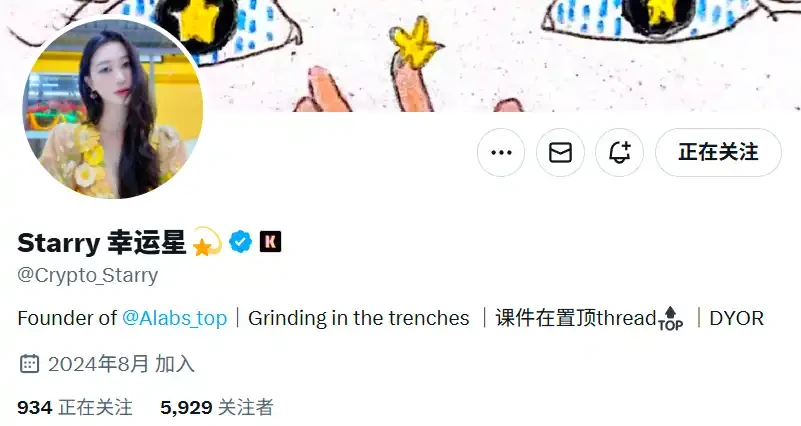
Token 2049: Five thoughts after running the game:
1. Fewer and fewer people: While hotels in Singapore are expensive this year, that's likely due to National Day and the F1 race, so they're still far less expensive than last year. This doesn't mean the crypto community is deserted; it's more likely that more and more people are realizing that the best way for ordinary people to earn positive EV is to "sit back," not "socialize." PS: @EnHeng 456 might be an exception; I'd also love to learn how Enheng made the transition from socializing to trading.
2. Business Development (BD) dominated the crowd: I went to Singapore to complete work tasks. Although I knew that most of the people there were BDs, I still had a small chat at the venue. Sure enough, most of them were BDs or people from MKT agencies who came to solicit business. Occasionally there were a few KOLs, which was too rare.
3. Private meetings are the most effective: You can only reach the big guys and your inner circle in private meetings; public speeches don't count, and you won't get anyone to talk to you. For upward networking and building connections, private meetings are the most effective. This year, I saw @gmgnai hold an invitation-only yacht event, and countless English-speaking traders, like @ihateoop and @orangie, were so excited that they tweeted endlessly overnight. Meanwhile, projects that held public events burned through the cash, but saw little impact.
4. The above phenomenon shows that the path to advancement for ordinary people is shrinking: in the past, it was still possible to meet a few big names at conferences. Now, all that matters is invitation-only private meetings. If you don't have the skills, or don't know how to pretend to have them, it's hard to meet big names.
5. Demystify: See and magnify the shining points of others, learn from them. See through the leverage that others secretly add when they speak, and demystify them.
Zixi.bnb (StableStock CEO)
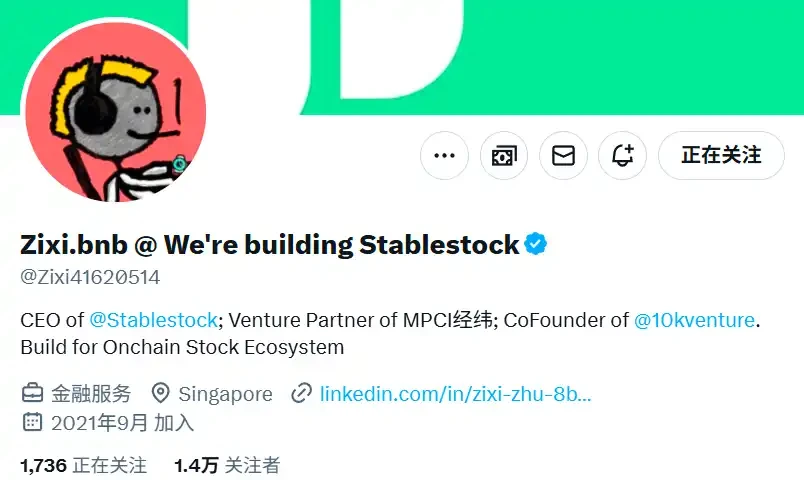
This 2049 event was my fourth at SG, and my first as a Founder, transitioning from an investor/GP role. The past three 2049 events were mostly a chaotic mess, attending events and tradeshows large and small without a focused focus. The result was exhaustion and low value for money. This time, however, I had a clear vision of what I wanted, so I focused on attending a few smaller events and conferences. Conversely, I didn't feel tired at all, and I was incredibly productive.
Since Stablestock will launch our first batch of stock tokenized products on BNB Chain’s Native next week, we organized a small private dinner and invited our MMs/KOLs/partner organizations to come over. Since the number of people was controlled within 50, the communication effect among everyone was very good (and it was also the first time I had a full meal at an event since I participated in 2049 4 years ago).
My biggest takeaway from attending 2049 in late September and several events at ETH NYC in August is that RWA/tokenized stocks are taking over the world. An investor I met at 2049 was very bullish on us and famously said, "If stablecoins are the L2 of the US dollar, then tokenized stocks are the L2 of stocks. Furthermore, they are the new downstream of the stablecoin ecosystem and the L3 of stablecoins." While RWA has already proven its direction with stablecoins/US dollars, the next wave of proven tracks will be stocks with greater transparency, redemption, and minting capabilities.
Nowadays, not only cryptocurrency investors and exchanges, but also many investors in traditional industries are paying attention to Robinhood, Ondo, Xstock, and Stablestock. They are looking to use our platform to bridge the gap between TradFi and DeFi, leveraging new assets to build new products on-chain. Beyond traditional products like ETFs and lending, I've seen crypto developers looking to use tokenized stocks to build stablecoins. This is a very creative idea. They can collaborate with web 2 fintech giants and, through their middleware, reach countless web 2 brokers, bringing immense stock liquidity to the chain.
Many of these founders/investors have really creative minds, and every idea they come up with represents an opportunity for the StockFi track. I welcome relevant entrepreneurs to contact me and discuss ideas with me, so that we can expand the StockFi track together.
CHI Labs
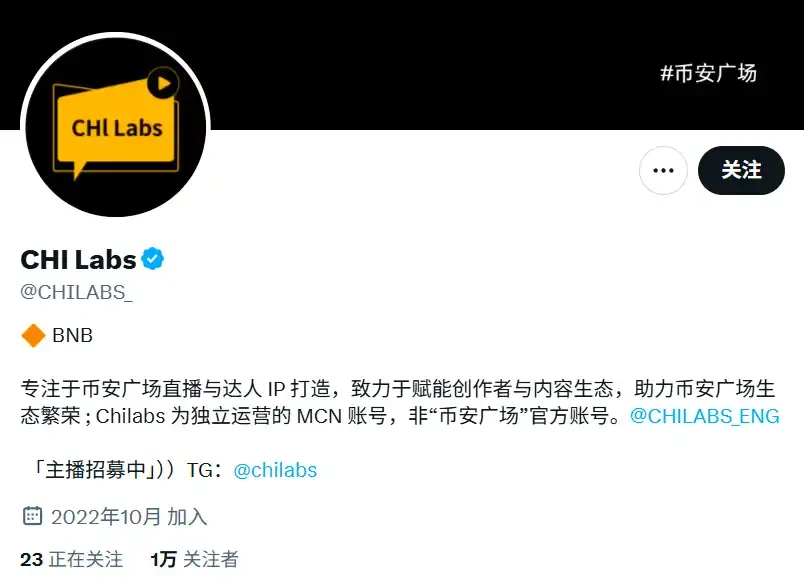
Token 2049 Personal Experience:
1. Go where users make decisions and speak in a language they understand
The hype surrounding Token 2049 has faded, and as the revelry fades, a question more acute than any Alpha has surfaced: Where are the Chinese users, the project's developers and builders? Over 500 events in Singapore this year transformed the Sands into a temporary "crypto mecca." However, beneath the spectacle, a quiet shift in Chinese users' attention has long since settled.
1. A brutal reassessment of the value of attention
For attendees three years in a row, the Token 2049 venue itself has been a brutal history of rise and fall. Last year, VCs had to queue up to see the star public chains and Layer 2 concepts, but this year, the surrounding events were so deserted that they resembled performance art. In stark contrast, projects closer to the transaction and application layers, like Hyperliquid and Aster, have become new traffic black holes, their booths and events packed with users eager to find the next opportunity.
Attention is rapidly shifting from grand narratives to "wealth codes I can immediately participate in." The rise and fall cycles of projects have been compressed to an extreme, essentially a brutal reassessment of the market's "value of attention."
2. Marketing "cognitive mismatch": Why is Twitter marketing failing?
During the conference, we spoke with many founders of popular projects, and nearly every one shared a similar dilemma: "The data in the Chinese market is shit." Unlike South Korea and Western countries, where Twitter is the dominant platform, these companies face a common dilemma in the Chinese market: investing massive amounts of money in Twitter only to see engagement numbers that don't match actual growth. This isn't a strategic mistake, but rather a profound cognitive mismatch. We need to consider a fundamental question: Who are the Chinese users, and where are they located?
1. Twitter's "Existing User" Dilemma: The Chinese crypto community on Twitter is more like an "industry insider circle," or "existing market," comprised of KOLs, VCs, project developers, and media outlets. These users are seasoned and immune to marketing rhetoric. They pursue in-depth research, technological breakthroughs, and early, reliable alpha. Your "broad-area bombardment" marketing is just noise to them. Talking to them is more like "self-congratulation" within the industry. New users don't know how to find crypto information on Twitter.
2. Where are the real "incremental users"? Now, let's describe a true new Chinese user—the "outsider" drawn in by Bitcoin's new highs, the Trump Token, and a friend's sudden wealth story. Their time and energy are precious, and their core concern is, "How can I quickly, simply, and safely participate?" Their path is eerily clear:
Step 1 (5 minutes): I downloaded Binance after a friend recommended it to me. Step 2 (30 minutes): I learned the basics of OTC and trading.
Since then, due to user habits and path dependency, he prefers to complete 99% of his crypto lifecycle within this app. Why? Because the exchange solves his biggest pain points: trust and efficiency. In a world of information overload and rampant scams, the exchange app is not just a trading tool; it's his "information center" and "decision-making brain," the very thing he relies on for survival.
For a long time, he had no interest in learning the complexities of DeFi on Twitter, couldn't distinguish between various L2 "Rollup" technologies, and had no idea how to sift through information. He preferred to track market trends through the exchange's "Square" or "Discover" pages, find potential wealth codes in the new coin lists, and participate in new coin issuance with one click on Launchpad. For him, the exchange app is an information portal, a decision-making center, and a trading terminal.
One indisputable fact is that new users' minds are completely locked in by the super app that is the exchange. Countless project owners are still engaged in a scramble on Twitter, attempting to educate users in the Chinese market who don't need to be educated, while their true potential users lie behind a layer of glass, waiting to be discovered in the exchange's traffic pool.
3. Go where users make decisions quickly and speak in a way they understand
In summary, the era when Twitter storytelling alone could drive growth is behind us. The key to success now lies in diversified marketing, not just relying on Twitter for cross-platform traffic generation, but also in directly reaching users where they make decisions. Projects need to shift from "wide-area bombing" to "precision-guided" campaigns, accomplishing three things within Binance Square, the core battleground for targeted users:
- Being seen: Users can effectively showcase themselves when browsing information on Binance Square.
- Be understood: Explain your value in the most straightforward language that is closest to the "code of wealth".
- Be traded: Allow users to complete interactions or transactions with the lowest threshold with just one click the moment they become interested.
This is exactly the direction ChiLabs is going all in. We chose to go to Binance Square, the terminal for traffic.
BruceLLBlue (crypto investor)
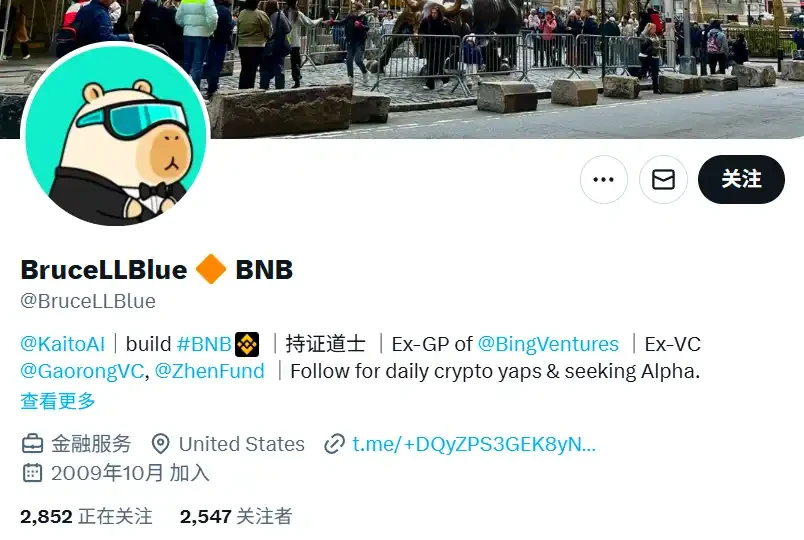
Let me share my biggest impressions of Token 2049 this year:
Stablecoins and RWAs are merging with traditional finance. Everything can be RWA, and a large number of institutions are working together to develop their own DAT projects.
Traditional institutions and Wall Street rushed into the market, and Crypto's pricing power gradually eroded; regulations gradually became clearer, and real technology began to be implemented;
Many Asian VCs that only invest in primary funds are laying off staff, reorganizing, or even closing down due to low returns and the difficulty in raising new funds.
Infra is slowly fading, even its events are deserted; consumer-oriented projects like @moonbirds and @pudgypenguins are always packed with people;
AI and Crypto are converging at an accelerated pace. The agent economy is taking off, and Info-Fi is replacing many traditional agencies. AI-based projects are gradually finding their own application scenarios.
In addition to exchanges, this year's major sponsors include @Polymarket and @DWFLabs. There are rumors that Polymarket will hold a TGE in Q4.
Dave.bc 1 q. (@0 xUClub President)
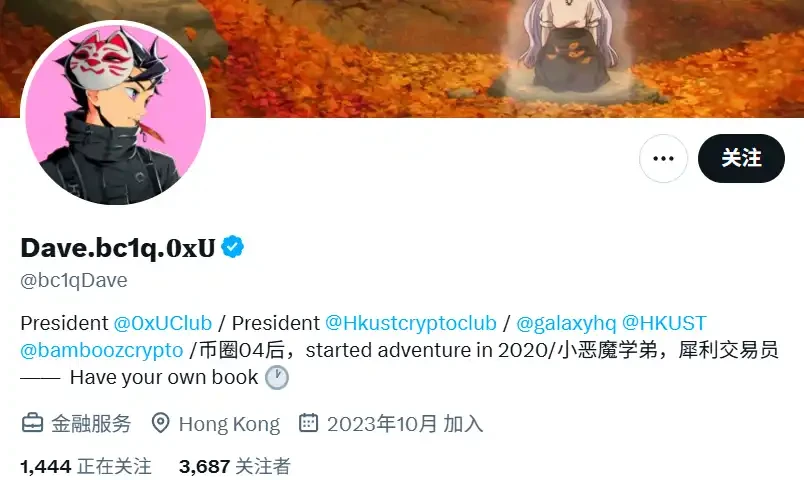
Innovation is fading, capital is driving the market—the illusions of the Token 2049 boom. This year's 2049 social model marks a massive paradigm shift. Recently, an article has gone viral titled "Seeing the Beauty of Economic Upturn in Token 2049." I don't want to criticize it with overly harsh language, but firstly, the author is quite good at choosing titles. Secondly, having not personally attended the meetings and chatted with the literati, I see more of an innovation drought, liquidity anxiety, and capital-driven development, all creating a massive illusion on the rosy slopes of the industry.
The impression given by various ecosystems is that innovation is fading: old narratives, old ways of playing, and old foundations throwing money around. Since my friends in some ecosystems may see this article, I won't elaborate here; let's just offer a more abstract critique.
There are no interesting projects on the real business side. They either rehash previously mentioned tropes, some of which have even been disproven. Or they're just wild, unrealistic fantasies with no real business case.
The direction of the foundation/project leader is unclear or very stupid. In fact, it is also a kind of helplessness, because they don’t know which direction to go, so they can only choose a more reliable one.
Exchanges were the most active institutions in the 2049 event, but beneath the excitement lay a severe liquidity crisis. There were no more "leeks," and even fewer traders. I was deeply disappointed after visiting the main venue. I angrily told a friend that it was "an online gambling platform running a pyramid scheme." Of course, calling them online gambling platforms is wrong. But exchanges certainly filled the main venue booths, and everyone's frantic promotions only revealed a severe shortage of liquidity.
Following up on the previous topic, we move on to the next characteristic: capital-driven growth. The business paradigm of this wave is characterized by small-scale conspiracies and smuggling syndicates. Familiar individuals across the entire ecosystem conspire together, from asset sales to final liquidity exits. Money is incredibly hard to earn, yet, with the impending bull market, it's incredibly easy to earn. But what kind of business can truly generate profit? From project sponsors, VCs, incubators, agencies, and exchange buying communities, let's build something together.
This paragraph specifically addresses the entire ecosystem. Don't misunderstand, I'm praising you. I think this model is smart and effective, and it's the answer to the meta. Therefore, the small-scale team-building model described above represents the current meta. The previous large-scale BD and large-scale alliance playstyle is no longer suitable. I'm also forming a small Alpha team myself, and I welcome discussions with other teachers.
Life-saving: I did not say that any of the projects above are bad. SOL has become a hot commodity for institutions, Hyperliquid has gained both fame and fortune, and OKX is leading the way in its home turf. Everyone is doing well and has a bright future.



